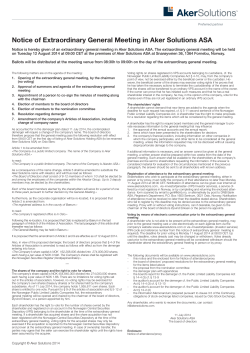
How to Increase the Life Expectancy of the Equity Plan’s Share Reserve Speaker:
How to Increase the Life Expectancy of the Equity Plan’s Share Reserve Presentation for: Speaker: NASPP, Austin Chapter May 1, 2013 Anthony J. Eppert, Shareholder Winstead PC © 2013 Winstead PC 713.650.2721 aeppert@winstead.com About Anthony (“Tony”) Eppert Tony is a Shareholder in Winstead’s Compensation & Benefits practice group. His legal practice focuses on executive compensation and employee benefit arrangements in the United States and internationally Before entering private practice, Tony: – Served as a judicial clerk to the Honorable Richard F. Suhrheinrich of the United States Court of Appeals for the Sixth Circuit – Obtained his LL.M. (Taxation) from New York University – Obtained his J.D., cum laude (Tax Concentration) from Michigan State University College of Law Editor-in-Chief, Journal of Medicine and Law President, Tax and Estate Planning Society iii Additionally, Tony is a leading writer for Compensation Committee Corner, a blog tailored to compensation committee members of board of directors. See www.CompensationCommitteeCorner.com © 2013 Winstead PC Upcoming Webinar Programs 2013 webinars: – – – – – – – – iv Effective Fiduciary Structures: Employer Stock & Retirement Plans (May 8) “Must Know” Securities Rules: 10b5-1, Section 16, 8-Ks, etc. (June 12) The Impact of FATCA on Compensatory Arrangements (July 10) Non-Economic Terms: Structuring Non-Competes/Clawbacks (Aug 14) How to Effectively Prepare for Proxy Season (Sept. 11) Equity Plans and International Financial Reporting Standards (Oct. 9) Compensation & Benefits: A Legislative & Regulatory Review (Nov. 13) Effective Performance-Based Incentive Designs (Dec. 11) © 2013 Winstead PC Purpose of Seminar For publicly held companies, an increase in the share reserve of an equity incentive plan requires shareholder approval under NYSE and NASDAQ listing rules – Additionally, for public and private companies, shareholder approval is also required if any of the shares subject to the increase can be subject to incentive stock option treatment A problem can arise when management and/or the Board either: – Disfavors asking shareholders to approve an increase in the number of shares, or – Seeks shareholder approval for less than the desired number of shares due to concerns from institutional shareholder advisory services, market cap concerns or other factors The purpose of this seminar is to discuss how a company can increase the life expectancy of the equity plan’s share reserve. Specifically, this seminar discusses: – – – – – – 1 Use of stock-settled SARs or net exercised stock options, Use of restricted stock awards or RSUs, Use of “inducement” grants, Automatic forfeitures if the stock price falls below a certain value threshold, Use of treasury stock in conjunction with an elective program, and Implementation of an employee stock ownership plan © 2013 Winstead PC Background: ISOs and NSOs An ISO is a type of stock option that is preferred by optionees (compared to NSOs) because of their favorable tax treatment – ISOs can only be granted to employees – No taxable income is triggered to the optionee at the time of grant – No taxable income is triggered to the optionee at the time of exercise However, the spread between the FMV of the underlying stock and the exercise price would be an item of adjustment for purposes of calculating any AMT – If the stock is held for at least 2 years from the date of grant AND at least 1 year from the date of exercise (the “Holding Period”), then any gain realized on a subsequent sale of the underlying shares would be taxed at capital gains rates Neither the grant nor the exercise of an ISO provides the company with any compensation deduction In contrast, NSOs are stock options that do not satisfy one of the many requirements for ISO treatment – No taxable income to the optionee on the date of grant – At exercise, the difference between the FMV of the underlying stock as of the date of exercise and the exercise price is ordinary income (the company receives a corresponding deduction) – At sale, the difference between the stock’s tax basis and the sale price can be captured at capital gains rates 2 © 2013 Winstead PC Background: Stock Appreciation Rights A stock appreciation right (a “SAR”) is similar to an option except that a SAR represents a “promise” to pay (rather than a current grant) and provides the participant with the right to receive an amount in cash/stock equal to the excess, if any, of the FMV of a share of common stock as of the settlement date over the “base appreciation amount” – Until settled, a SAR represents no ownership interest in the company – The base appreciation amount is typically the FMV of the company’s common stock on the date the SAR is granted – The promise is “settled” on a pre-chosen date Example: Grant 1,000 SARS with a base appreciation amount of $20 per share. If the SAR vested and settled when the company’s stock price is $50, then the SAR would be settled for a cash payment equal to $30,000 (1,000 x $30) or the issuance of 600 shares ($30,000/$50) Tax treatment to participant: – At settlement, the participant would have ordinary taxable income equal to the FMV of the spread Tax treatment to the company: – A compensation deduction would be triggered at settlement – Additionally, the company would have a withholding obligation if the participant is an employee 3 © 2013 Winstead PC Background: Restricted Stock Generally, the grant of restricted stock would constitute a corporate transfer, but not a tax transfer, at the time of grant – A corporate transfer means the recipient is entitled to voting and dividend rights even if the award is subject to forfeiture – If the award is subject to forfeiture (i.e., a vesting schedule), then the tax transfer typically coincides with vesting Tax treatment to the participant assuming no 83(b) election was timely filed: – Unless an 83(b) election is timely filed, the participant would generally recognize ordinary taxable income equal to the FMV of the award (less any amount paid) as of the earlier of: (i) the date the shares become transferable, or (ii) the date the forfeiture restrictions lapse (i.e., the date of vesting) – Until such above date, any dividends received by the participant would be treated as compensatory income, not dividends – After such above date, any sale of the underlying stock would be treated as capital gain or loss equal to the difference between the sale price and the tax basis 4 © 2013 Winstead PC Background: Restricted Stock (cont.) Tax treatment to participant assuming an 83(b) election was timely filed: – The participant could attempt to capture as much of the anticipated future appreciation of the underlying stock at capital gains rates by making an “83(b) election” within 30 days from the date of grant The purpose of an 83(b) election is to try and limit the ordinary taxable income to the value of the stock on the date of grant (which can be much lower than the amount of ordinary taxable income the participant would otherwise recognize at the time of vesting) This means the participant would be taxed at the time of grant (at a time when the FMV of the stock may be lower than at the time of vesting) Thereafter, any increase in the FMV of the stock subject to the 83(b) election would typically be taxed at capital gains rates when the participant sells the stock Tax treatment to the company: – If the participant is an employee, the company would have a withholding obligation and employment taxes at the time the participant recognizes ordinary income – Additionally, the company would have a corresponding compensation deduction at that time 5 © 2013 Winstead PC Background: Restricted Stock Units A restricted stock unit (an “RSU,” also known as “phantom stock units”) are similar to SARs in that they represent a “promise” to pay as opposed to a current grant – However, different from a SAR, an RSU provides the participant with an amount in cash/stock equal to the full FMV of a share of common stock (i.e., also known as a “full value award”) – Assuming an RSU is to be settled in stock, an RSU represents no ownership interest in the company UNTIL the settlement date – The promise is “settled” on a pre-chosen date: Example: Grant 1,000 RSUs that vest at a time when the company’s stock price is $50. When the RSUs vest, the participant would receive cash/stock equal to $50,000 (1,000 x $50) or 1,000 shares of common stock (with a value equal to $50,000) Tax treatment to participant: – At settlement, the participant has ordinary taxable income equal to the FMV of the amount settled Tax treatment to the company: – If the participant is an employee, the company has a withholding obligation (income and employment taxes) at settlement – A compensation deduction would be triggered at settlement 6 © 2013 Winstead PC Idea No. 1: Use Full Value Awards The use of full value awards such as restricted stock and RSUs require less shares to provide the same economic value as a stock option – Bit remedial, but worth mentioning 7 © 2013 Winstead PC Idea No. 2: Implement Stock Price Forfeitures The following sets up the problem: Generally, if a company wants to reprice underwater stock options, the company would have to file a Schedule TO unless: – The repricing is conducted on an individually negotiated basis with a small number of key executives (see March 21, 2001 Exemptive Order); or – A repricing is permitted unilaterally (i.e., without optionee consent), thus negating the TO rules because there is no “offer” under applicable securities rules (i.e., the optionee would not make any investment decision) Obviously, other issues to consider when repricing stock options include: – Whether the cancelled shares return to the share reserve under the equity plan; – Whether shareholder approval is required under the terms of the equity plan, NYSE or NASDAQ rules; and – Whether adverse tax and accounting consequences can be avoided 8 © 2013 Winstead PC Idea No. 2: Implement Stock Price Forfeitures (cont.) The idea is simple. The stock option award agreement provides that if the stock option ever becomes underwater by $x.00, then it is automatically forfeited – The forfeited shares then return and replenish the share reserve The goal is to avoid the time, expense and shareholder relationship issues associated with repricings and compliance with the SEC’s tender offer rules Risk to be vetted – If you are considering implementing a stock price forfeiture, you will need to get comfortable with the risk that such a forfeiture could be deemed a “cancellation” under NYSE and NASDAQ listing rules, thus be deemed a “repricing” subject to shareholder approval 9 © 2013 Winstead PC Idea No. 3: Net-Exercised Stock Options In the stock option context, a “net exercise” is similar to a brokerassisted cashless exercise, except that with net exercises there is no open market transaction – Instead, a portion of the exercised shares equal in FMV to the exercise price is tendered to the company in lieu of the optionee paying the exercise price in cash For example: – For example: Assume a holder is granted an option to purchase 8 shares of stock with an exercise price of $1.00 per share (i.e., FMV as of the date of grant) – Assume further that at the time of exercise the FMV of the underlying stock is $4.00 per share – In this example, a net exercise means the holder would tender 2 of the 8 shares of common stock in exchange for paying the exercise price of $8.00 – Immediately thereafter, the holder would own 6 shares of common stock having a then FMV of $24.00 – The two shares tendered would return to the share reserve, BUT BEWARE that ISS considers this practice to constitute liberal share counting 10 © 2013 Winstead PC Idea No. 4: Stock-Settled SARs Stock-settled SARs generally provide the holder with the number of shares of stock equal in FMV to the accumulated appreciation in the underlying stock from its FMV at the date of grant – However, unlike net-exercised stock options, no shares are tendered to the company Using the same example as the prior Slide, the accumulated appreciation of the underlying stock from the date of grant would also provide the holder with 6 shares of stock (i.e., $24.000 of accumulated appreciation divided by $4.00 per share) Thus, compared to a net exercised stock option, the holder and the share reserve are in the same position, except that: – The holder lost the “optionality” that accompanies a stock option 11 © 2013 Winstead PC Idea No. 3 & 4: SARs and Net Exercises: Advantages Compared to stock options utilizing a cashless exercise feature, the advantages of net exercises and/or stock settled SARs include: – Assuming the plan document contains appropriate share counting provisions, the life expectancy of the equity plan’s share reserve should be longer because a lesser number of shares are issued. This could then lessen the frequency within which shareholders are asked to increase the equity plan’s share reserve – Reduced shareholder dilution because only the net shares are considered issued and outstanding – The holder receives the same economic benefit as stock options with a cashless exercise feature (only economic difference could arise if the optionee were to exercise without a cashless exercise feature and hold the resulting shares) – Broker fees associated with cashless exercises are avoided – There could be less problems associated with insider trading blackout periods since net-exercises and/or stock-settled SARS do not use open market transactions 12 © 2013 Winstead PC Idea No. 3 & 4: SARs and Net Exercises: Disadvantages Compared to stock options utilizing a cashless exercise feature, the disadvantages of net exercises and/or stock settled SARs include: – The company may have decreased cash flow because no monies are paid to the company in conjunction with an exercise – The holder may be unable to obtain favorable incentive stock option treatment – Depending upon the underlying facts, it may become more burdensome for the company to satisfy its withholding obligation – Shareholder advisory services such as ISS might assign a higher cost to the awards than it would traditional stock options 13 © 2013 Winstead PC Idea No. 5: Inducement Grants Under both NYSE and NASDAQ listing rules, shareholder approval of inducement grants to new hires is NOT required To qualify as an inducement grant, the grant of restricted stock or stock options must act as a material inducement to the person being hired as an employee (or such person being rehired following a bona fide period of interruption of employment) – Inducement awards include grants to new employees in connection with an M&A transaction 14 An additional qualification requirement is that promptly following any such inducement grant, the company must disclose in a press release the material terms of the award, including the identity of the recipient(s) and the number of shares involved © 2013 Winstead PC Idea No. 5: Inducement Grants (cont.) In terms of the “form” of award, some companies provide inducement grants as stand-alone awards, whereas some others will have an inducement plan from which to make grants (the latter particularly prevalent in M&A transactions) Important to note is that inducement grants are “outside” of the shareholder approved equity incentive plan – Therefore, inducement grants are not covered by the equity plan’s S-8 15 If the inducement grant covers stock options, the filing of a Form S-8 should be considered However, if the inducement grant covers restricted stock, then a Form S-8 may not be necessary given the analysis contained in the following two slides © 2013 Winstead PC Idea No. 5: Inducement Grants (cont.) Under the “bonus stock exemption,” restricted stock held by a plan is treated as if it were registered stock (regardless of whether the plan is an affiliate) if certain conditions are satisfied – Authority is contained in Release No. 33-6188, Release No. 33-6281 and a series of no-action letters Thus, registration of the securities is not required Only applies where no consideration was paid (i.e., no “sale”) – Thus, exemption is not available for stock options – Query whether exemption is available if the employee only pays par value Addressing resales by participants who are non-Affiliates, shares distributed would not be considered “restricted securities” and could be resold immediately even though such shares were not registered (i.e., sold without having to comply with Rule 144) – Addressing resales by participants who are Affiliates, compliance with Rule 144 would be required 16 © 2013 Winstead PC Idea No. 5: Inducement Grants (cont.) Conditions that must be satisfied for the bonus stock exemption to apply: – Issuer must be subject to periodic reporting requirements of Section 13 (i.e., employers that have registered stock under the ’34 Act) or Section 15(d) (i.e., employers that have registered stock under the ’33 Act) of the ’34 Act, – Stock being distributed must be actively traded, and – Amount distributed must be “relatively small” in relation to the total number of that class issued and outstanding Release 33-6281 (Jan. 15, 1981) defining “relatively small” – Distribution is always relatively small if the total number of shares distributed during the fiscal year is less than 1% of the outstanding stock for that year – A larger distribution may be relatively small if it would not have a measurable impact on the trading market (according to a no-action letter concluding that 5% was “relatively small”) 17 © 2013 Winstead PC Idea No. 6: Treasury Stock The following use of treasury stock could be implemented for the benefit of directors and/or executive officers, but for purposes of this discussion, we will assume such is implemented by outside directors Overview of the program – The annual director fee of cash is deposited into a brokerage account; – Each outside director elects the percentage of the fee that they will direct toward a FMV purchase of treasury stock (idea being 100%, minus the monies to pay the taxes associated with the director’s receipt of the fee); – The brokerage shop executes the trade on the director’s behalf, consistent with instructions, depositing treasury shares into their account and delivering cash to the company based on the FMV of the company’s stock on the day the trade is executed (no discount); – Brokerage fees could be paid by the company The company’s cash outlay is essentially returned, except for the amounts used by the directors to satisfy their income tax liability Issues to consider include: – A plan document is required – A Form 8-K would be required – A Form S-8 covering the shares should be filed 18 © 2013 Winstead PC Idea No. 6: Treasury Stock (cont.) Advantages of a treasury stock purchase program – Shareholder approval is NOT required under NYSE and NASDAQ rules; – There is no dependency upon the share reserve of the equity incentive plan, thus such share reserve is preserved; – It encourages ownership in the company, thus serving the purpose of aligning the director’s interest with those of the company ‘s shareholders; – Can help to facilitate stock ownership requirements/guidelines, which can act as a mitigating factor to negate “materiality” in the risk assessment process; – It is more efficient than open market purchases since all directors would be able to satisfy their ownership goals on the same day rather than over an extended period of time (the latter of which could otherwise be required if there were low trading volume); – It is more equitable than director purchases in the open market because all directors will pay the same price (open market purchases could result in price disparity depending on when purchases take place); – Scheduling of purchases shortly after earnings release provides transparency and reduces risk of allegations regarding the use of insider information; and – Issuances from treasury stock adds a small amount to the outstanding share count, which increases market cap (helping to satisfy ongoing listing requirements) 19 © 2013 Winstead PC Idea No. 7: Employee Stock Ownership Plan For those companies who provide ownership deep into the employee pool, consideration should be given to an employee stock ownership plan (an “ESOP”) One advantage of an ESOP is that shareholder approval is NOT required to implement an ESOP – For public companies, NYSE and NASDAQ listing rules generally provide that plans intended to satisfy the requirements of Section 401(a) of the Internal Revenue Code are exempt from the shareholder approval requirement Another advantage is that ESOPs can help a public company defend against a hostile takeover – Studies show employees vote favorably with management when a possible hostile takeover exists because employees fear a takeover would result in loss of jobs – Voting rights of allocated shares would be passed through to ESOP participants in tender offer situations – A mirror provision could be implemented whereby ESOP trustee would vote unallocated ESOP shares in same manner/percentage as allocated shares were voted by ESOP participants; though ESOP trustee would not be required to follow mirror provision where its fiduciary duties dictated otherwise 20 © 2013 Winstead PC Idea No. 7: Employee Stock Ownership Plan (cont.) Whether registration is required depends upon the structure of the ESOP In a series of releases, the SEC concluded that the grant of stock pursuant to an ESOP would generally not constitute an offer and sale if no value is paid in connection with the grant – Continued employment or the obligation to perform future services does not constitute value for this purpose However, registration would be required if the employee has discretion on whether to participate in the ESOP and has the right to direct the investment of his or her account balance – For this purpose, a participant’s right to diversify during the qualified election period is disregarded Though registration of the underlying ESOP securities may not be required, a company might wish to consider registration so as to facilitate resales by participants who are affiliates – Otherwise, the bonus stock exemption could apply 21 © 2013 Winstead PC Idea No. 7: Employee Stock Ownership Plans (cont.) If registration is desired or required, then a Form S-8 should be used – A prospectus must be delivered to eligible employees (such is not filed) – An annual report on Form 11-K is required, which obligation could be satisfied by filing the financial statement required by Form 11-K with Form 10-K. Certifications under SOX 302 and 906 are not required 22 © 2013 Winstead PC
© Copyright 2025











